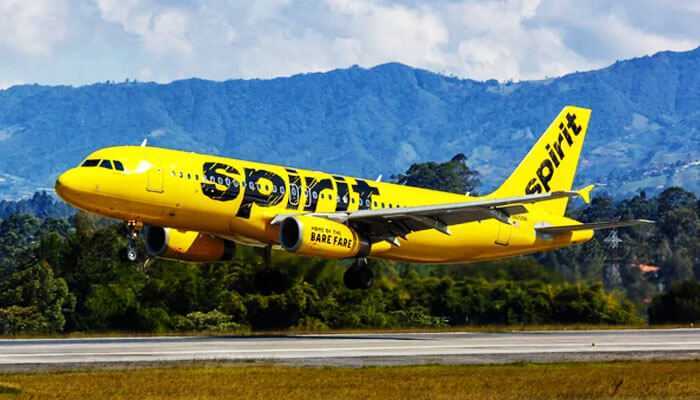Introduction
In a stunning turn of events, Spirit Airlines reveals itself amid an excessive monetary crisis as its stock takes a nosedive, plummeting by an impressive 50% following a judge’s choice to dam the proposed merger with JetBlue. This sudden setback, which has caught enterprise specialists off guard, has sent shockwaves via the airline enterprise, leaving buyers and stakeholders scrambling for answers and fearing the worst.
The blocked merger not only poses instant financial challenges but also triggers lengthy-term implications for Spirit Airlines, forcing the business enterprise to reevaluate its growth strategies and survival techniques in an especially aggressive market. As the inventory keeps its downward spiral, traders and analysts anxiously watch for the airline’s next move, speculating on potential restructuring plans or partnerships that may be important to navigate this turbulent typhoon.
With an uncertain future, uncertainty grips the organization’s personnel, who worry about capacity activity loss and restructuring efforts. As Spirit Airlines navigates through this tumultuous period, the enterprise’s eyes are constant upon its capability to weather this monetary typhoon and emerge stronger, in search of modern answers and strategic alliances that would potentially reshape its trajectory. In this newsletter, we delve into the problematic details of the situation, exploring not only the on-the-spot and long-term implications of the blocked merger but also the broader demanding situations that lie ahead for Spirit Airlines and its stakeholders.
Background of JetBlue Merger:
The merger between Spirit Airlines and JetBlue has been extraordinarily anticipated and predicted to have a profound effect on the aggressive landscape of the airline enterprise. It became visible as a major game-changer, with the potential to reshape enterprise dynamics. By joining forces, the goal was to create a stronger entity that could effectively undertake the dominance of large carriers and considerably amplify its market proportion. The merger was driven by the shared imaginative and prescient efforts of each business to leverage its complementary strengths and sources. They have been positive about the synergy and operational blessings that could come from this partnership. It was anticipated that the merger could result in huge financial savings, economies of scale, and improved operational efficiencies. Additionally, the mixed entity aimed to decorate its carrier services, providing clients with a wider range of alternatives and a better-than-usual flying experience.
The legal roadblock:
However, the bold plans hit a roadblock as a judge intervened, setting a surprising halt to the proposed merger. The legal project raised critical questions about the compatibility of the merger with existing guidelines and the capability of anti-aggressive outcomes, casting doubt over the prospects of the two businesses concerned. As the court docket drama unfolded, traders nervously watched as the judge’s decision reverberated via economic markets, triggering an unprecedented 50% drop in Spirit Airlines’ inventory value, inflicting massive panic among shareholders, and raising concerns about the general stability of the aviation enterprise.
Immediate Market Response:
The immediate aftermath of the investor’s choice noticed a flurry of pastime on the stock market. Investors, fearing further losses, rushed to sell off their once-promising Spirit Airlines stocks, leading to a pointy decline in the inventory charge. This unexpected and dramatic downturn left analysts and monetary experts scrambling to assess the whole quantity of the implications, with many expressing deep concern over the lengthy-term viability of Spirit Airlines in the wake of this kind of substantial blow. Some even puzzled whether the airline would be capable of recovering from this type of devastating setback, as the future of the industry itself was regarded as uncertain. In a matter of hours, Spirit Airlines found itself tumbling right into a nation of profound uncertainty, with its very survival at stake and its reputation hanging in the balance.
Impact on Stakeholders:
The sudden and drastic 50% stock plummet had a profound and long-awaited effect on diverse stakeholders associated with Spirit Airlines. Shareholders, which include institutional traders and individual stockholders, confronted vast and extensive losses because the marketplace reacted to the sudden blockage of the merger. The drastic decline in stock value no longer only resulted in economic hardships for shareholders but also caused worries and uncertainty about the enterprise’s typical stability and capability to recover from this sort of extreme economic setback. Consequently, questions and doubts arose concerning Spirit Airlines’ potential to regain investor confidence in the aftermath of the failed deal and whether the company could correctly restore its marketplace role and profitability.
Operational and Strategic Repercussions:
In addition to the immediate financial consequences, the blocked merger has raised crucial and pressing questions about Spirit Airlines’ operational and strategic plans. The firstly anticipated and eagerly awaited blessings of the merger, along with potential course expansion, elevated operational performance, and improved customer support offerings, now hang precariously within the stability. With the merger now not intended as deliberate, Spirit Airlines must now undertake a comprehensive reassessment of its contemporary techniques, desires, and goals. The airline needs to search for revolutionary and alternative paths to navigate the increasingly tough and competitive landscape of the aviation industry while striving to stay profitable, applicable, and attractive to its current and future clients. Additionally, the business enterprise should cautiously bear in mind any potential effects on its operational prices, pricing techniques, fleet management, and typical commercial enterprise model. Therefore, it turns out that the blocked merger now not only influences present-day stakeholders but additionally calls for Spirit Airlines to engage in forward questioning and strategic decision-making to ensure its lengthy-term survival and prosperity.
Navigating the Legal Landscape:
In the wake of the judge’s choice to block the JetBlue merger, Spirit Airlines finds itself in a precarious position. The airline is expected to vehemently project the ruling, as they are seeking to overturn the block and proceed with the merger plans. This prison obstacle, however, isn’t expected to be easily overcome. Legal specialists predict a complicated and persistent criminal struggle, adding another layer of uncertainty to Spirit Airlines’ destiny potential. The final results of this felony undertaking will certainly have way-attaining implications for the airline, doubtlessly reshaping its trajectory and placing massive precedents for destiny merger tries within the enterprise.
Industry Response and Competition Dynamics:
The repercussions of this blocked merger extend beyond Spirit Airlines, reverberating across the wider airline industry. Competitors and regulators are intently monitoring this development, as it can affect their techniques regarding consolidation efforts. How other airlines respond to this setback will play a critical role in shaping the future panorama of the industry. Analysts are specifically interested in the capability ripple results this will have on future merger and acquisition strategies in the airline area. It could mark a decisive shift in the dynamics of opposition, making the JetBlue-Spirit Airlines case a watershed moment for the enterprise as a whole.
Rebuilding investor confidence:
With the blocked merger weighing heavily on Spirit Airlines, rebuilding investor confidence emerges as a paramount venture. The management of the business enterprise must undertake a strategic and concerted attempt to communicate a clear course ahead. This consists of outlining revised strategies and addressing the concerns raised by shareholders regarding the blocked merger. A properly executed verbal exchange approach, underpinned by transparency and accountability, could be instrumental in stabilizing Spirit Airlines’ stock rate and mitigating further damage to the airline’s economic fitness. Reassuring traders and demonstrating a steadfast commitment to adapting and thriving in the face of boundaries is critical to restoring faith and instilling self-belief in the airline’s destiny.
Conclusion:
In the wake of the company’s decision to dam the JetBlue merger, Spirit Airlines unearths itself in a state of unprecedented disaster, as evidenced by its stock plummeting a stunning 50%. This excessive setback has some distance-achieving implications, affecting not only the airline’s shareholders but also disrupting the dynamics of the whole industry. Moreover, the implications of this ruling go beyond the instant monetary ramifications and affect the airline’s strategic plans for the future. As Spirit Airlines navigates the treacherous prison challenges beforehand and urgently works closer to rebuilding investor self-assurance, the broader aviation industry watches with bated breath, acutely conscious that the final results of this excessive-stakes court case have the ability to reshape the entire landscape of mergers and acquisitions in the enterprise within the coming years.




